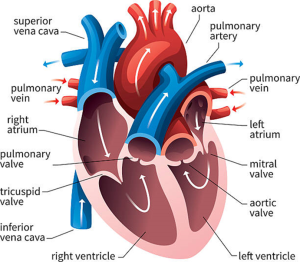Cardiovascular and Peripheral Vascular System
The human heart is one of the most critical organs of the body. Through its pumping action, the heart circulates blood throughout the entire body. Various mechanical processes and electrical pathways working together create the cardiac cycle, which is responsible for the heart’s ability to receive blood from the body, circulate it through the lungs, then return oxygen-rich blood to the heart to be pumped out to the entire body. Within the vascular system are the arterial, venous, and lymphatic systems that transport and circulate blood to and from the heart. Arteries carry blood away from the heart, and veins and lymphatics carry blood toward the heart.

LEARNING OBJECTIVES
- Review the basic anatomy and physiology of the cardiovascular and peripheral vascular (PV) systems.
- Complete a comprehensive assessment of the cardiac and PV systems.
- Understand the expected findings of a focused cardiac and PV assessment.
- Review common pathological signs and symptoms of cardiac and PV dysfunction.
- Learn appropriate documentation of assessment findings.
- Practice and apply critical thinking skills through applicable case study review.

